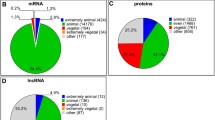Summary
For analysing spatial distribution of maternal proteins in an amphibian egg, monoclonal antibodies specific to certain regions were raised. One monoclonal antibody was found (MoAB Xa5B6) which reacted specifically with the animal hemisphere of the mature Xenopus laevis egg. The maternal protein that reacted with the MoAb Xa5B6 was shown to be distributed asymmetrically along the dorso-ventral axis in the upper region of the equatorial zone of the fertilized egg. At late blastula stage, the antigen protein could be observed clearly in both the marginal zone and animal cap. It was localized predominantly in mesodermal and ectodermal cells of late neurula embryos. The Xa5B6 antigen accumulated during oogenesis. The distribution pattern of maternal protein was remarkably different in the developmental stages of the oocyte. The pattern in the mature oocyte was completely different from that of the immature egg in which the antigen was located in the radial striations of the oocyte cytoplasm. After maturation, the distribution pattern changed drastically to an animal-vegetal polarization and the striation labellings were no longer observed. By Western blot examination, it was confirmed that the amounts of antigen protein were constant during early embryogenesis and the mesoectoderm contained a greater amount of antigens than the endoderm at late blastula. The antibody detected two bands of approximately 70 × 103 and 30 × 103 Mr by Western blot analysis. The latter molecule may possibly be a degrading moiety of the former. The results were discussed in relation to establishment of animal-vegetal (A/V) and dorso-ventral (D/V) polarization at the molecular level.
Similar content being viewed by others
References
Cooke J, Webber JA (1985) Dynamics of the control of body pattern in the development of Xenopus laevis I. Timing and pattern in the development of dorsoanterior and posterior blastomere pairs, isolated at the 4-cell stage. J Embryol Exp Morphol 88:85–112
Davidson EH (1976) Gene activity in early development. Academic Press, New York
Dreyer C, Scholz E, Hansen P (1982) The fate of oocyte nuclear proteins during early development of Xenopus laevis. Rouxs Arch Dev Biol 191:228–233
Dumont JN (1972) Oogenesis in Xenopus laevis (Daudin). I. Stage of oocyte development in laboratory maintained animals. J Morph 136:153–180
Imoh H (1984) Appearance and distribution of RNA-rich cytoplasms in the embryo of Xenopus laevis during early development. Dev Growth Differ 26:167–176
Imoh H, Miyazaki Y (1984) Distribution of the germinal vesicle material during progesterone-induced oocyte maturation in Xenopus and in Cynops. Dev Growth Differ 26:157–165
Itoh K, Yamashita A, Kubota HY (1988) The expression of epidermal antigens in Xenopus laevis. Development 104:1–14
Jackle H, Eagleson GW (1980) Spatial distribution of abundant proteins in oocyte and fertilized egg of Mexican axolotl (Ambystoma mexicanum). Dev Biol 75:492–499
Kageura H, Yamana K (1984) Pattern regulation in defect embryos of Xenopus laevis. Dev Biol 101:410–415
Kageura H, Yamana K (1986) Pattern formation in 8-cell composite embryos of Xenopus laevis. J Embryol Exp Morphol 91:79–100
King ML, Barklis E (1985) Regional distribution of maternal messenger RNA in the amphibian oocyte. Dev Biol 112:203–212
Miyata S, Kageura H, Kihara HK (1987) Regional differences of proteins in isolated cells of early embryos of Xenopus laevis. Cell Differ 21:47–52
Moen TL, Namenwirth M (1977) The distribution of soluble proteins along the animal-vegetal axis of frog eggs. Dev Biol 58:1–10
Nakazato S, Ikenishi K (1989) Monoclonal antibody production against a subcellular fraction of vegetal pole cytoplasm containing the germ plasm of Xenopus 2-cell eggs. Cell Differ Dev 27:163–174
Neff AW, Wakahara M, Jurand A, Malacinski GM (1984) Experimental analysis of cytoplasmic rearrangements which follow fertilization and accompany symmetrization of inverted Xenopus egg. J Embryol Exp Morphol 80:197–224
Nieuwkoop PD (1977) Origin and establishment of embryonic polar axes in amphibian development. Curr Top Dev Biol 11:115–132
Osada A, Suzuki AS (1987) Regional analysis of protein pattern during embryogenesis of Xenopus laevis. Memoirs Fac Gen Educ 22:1–16
Palecek J, Ubbels GA, Rzehak K (1978) Changes of the external and internal pigment pattern upon fertilization in the egg of Xenopus laevis. J Embryol Exp Morphol 45:203–214
Pasteels JJ (1964) The morphogenetic role of the cortex of the amphibian egg. Adv Morphogen 3:363–388
Phillips CR (1982) The regional distribution of poly (A) and total RNA concentrations during early Xenopus development. J Exp Zool 223:265–275
Smith RC, Neff AW, Malacinski GM (1986) Accumulation, organization and deployment of oogenetically derived Xenopus yolk/nonyolk proteins. J Embryol Exp Morphol 97 (Supp):45–64
Steedman HF (1957) Polyester wax. A new ribboning embedding medium for histology. Nature 179:1345
Tang P, Sharpe CR, Mohun TJ, Wylie CC (1988) Vimentin expression in oocytes, eggs and early embryos of Xenopus laevis. Development 103:279–287
Ubbels GA, Hara K, Koster CH, Kirschner MW (1983) Evidence for a functional role of the cytoskeleton in determination of the dorsoventral axis in Xenopus laevis eggs. J Embryol Exp Morphol 77:15–37
Wilson EB (1925) The cell in development and heredity. MacMillan, New York
Yisraeli JK, Sokol S, Melton DA (1990) A two-step model for the localization of maternal mRNA in Xenopus oocytes: Involvement of microtubules and microfilaments in the translocation and anchoring of Vg1 mRNA. Development 108:289–298
Author information
Authors and Affiliations
Additional information
Offprint requests to: A.S. Suzuki
Rights and permissions
About this article
Cite this article
Suzuki, A.S., Manabe, J. & Hirakawa, A. Dynamic distribution of region-specific maternal protein during oogenesis and early embryogenesis of Xenopus laevis . Roux's Arch Dev Biol 200, 213–222 (1991). https://doi.org/10.1007/BF00361340
Received:
Accepted:
Issue Date:
DOI: https://doi.org/10.1007/BF00361340




